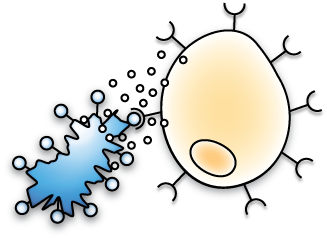
Theoretical Immunology
We take a computational systems biology aproach to studying the immune system. There are many ways in which this aproach will generate insight and improve our understanding of immune system behavior. An excellent review of where computational models can make a difference in immunology is "The Art of the Probable" by Ronald N. Germain. Our group is especially interested in the development of the adaptive immune repertoire, the collection of immune system receptors. Another great paper in theoretical immunology is "Immunology for Physicists," by Alan S. Perelson and Gerard Weisbuch.
| Immunosenescence is the changes in the immune system with age. This section of the site describes how the adaptive immune system can actually over-adapt and develop fragility to new diseases. This system effect differs from most views of aging where fragility is the consequence of an accumulation of defects. This effect of overspecialization clasifies the immune system as an example of Highly Optimized Tolerance. |
Homeostasis Here we are developing a model of lymphocyte homeostasis to understand what parameters and cytokine concentrations dictate the population numbers of different cell types in the immune system. (Page under construction, Sorry.) |
| Autoimmune Here we are looking at the dynamics of autoimmune disease. The receptors of lymphocytes are created at random and many are autoreactive. There is a selection procedure in the development of lymphocytes that eliminates those with autoreactive receptors. This research employs a stochastic model that predicts autoreactive escape, where autoreactive lymphocytes avoid the negative selection, and subsequent lymphocyte stimulation and development of autoimmune disease. (Page under construction, Sorry.) |
General Biology This section explores some aspects of modeling and dynamics that are of interest to a broad range of biological systems. In particular stochastic simmulation algorithims and the central limit theorem. (Page under construction, Sorry.) |
